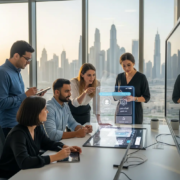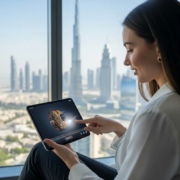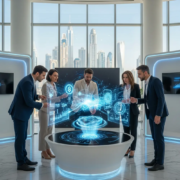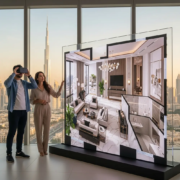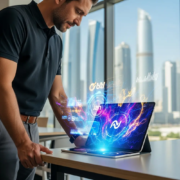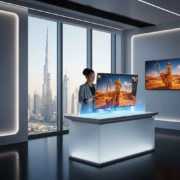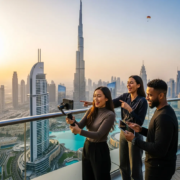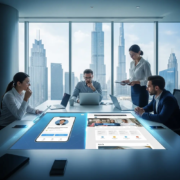Human-Centered Design: The Future of Dubai UX.
Human-Centered Design: The Future of Dubai UX
In an era defined by rapid technological advancement and an ever-increasing expectation for seamless digital experiences, the concept of user experience (UX) has transcended mere functionality to become a cornerstone of innovation and success. For a city as ambitious and forward-thinking as Dubai, which continually strives to be a global leader in smart services, tourism, and quality of life, understanding and implementing Human-Centered Design (HCD) is not just an advantage—it is an imperative. This article delves into Human-Centered Design: The Future of Dubai UX, exploring how this empathetic approach to problem-solving is shaping the digital landscape of the emirate, ensuring that every innovation, every service, and every interaction is meticulously crafted with the end-user at its very core. Dubai’s vision for a future where technology serves humanity demands a deep commitment to HCD, making it the driving force behind the next generation of experiences across government, business, and daily life.
Understanding the Core Principles of Human-Centered Design
Human-Centered Design (HCD) is an iterative design process that focuses on understanding the needs, motivations, and behaviors of the people for whom products and services are being designed. It’s a philosophy that places humans at the heart of the problem-solving process, moving beyond assumptions to gather real insights. This approach contrasts sharply with traditional design methods that often prioritize technical feasibility or business objectives over user needs. At its core, HCD is characterized by three fundamental phases: inspiration, ideation, and implementation. The inspiration phase involves immersing oneself in the lives of users to understand their challenges and desires. This often includes ethnographic research, interviews, and observations. The ideation phase then focuses on brainstorming solutions, prototyping, and testing these concepts with users to gather feedback. Finally, the implementation phase brings the most promising solutions to life, albeit with a continuous loop back to iteration and refinement. This iterative nature ensures that designs evolve based on real-world feedback, resulting in solutions that are not only effective but also highly desirable and intuitive. For businesses and government entities operating in Dubai, embracing these principles means creating offerings that genuinely resonate with a diverse, multicultural population, setting a new benchmark for excellence in the global digital arena.
Empathy: The Foundation of HCD
The cornerstone of Human-Centered Design is empathy. It involves stepping into the shoes of the user to truly comprehend their world, their challenges, and their aspirations. In the context of Dubai, a city celebrated for its multicultural population and diverse visitor base, empathy is not just a soft skill; it’s a strategic necessity. Designing for residents from over 200 nationalities, each with unique cultural nuances, expectations, and digital literacy levels, requires a profound empathetic understanding. This goes beyond simple demographics, delving into psychological needs, emotional responses, and contextual behaviors. By cultivating deep empathy, designers and strategists in Dubai can uncover unarticulated needs and create services that feel genuinely intuitive and respectful of individual differences. This foundational principle is what transforms a merely functional product into an experience that delights and empowers, fostering loyalty and satisfaction in a competitive market.
Iteration and Collaboration: Building Better Experiences
HCD thrives on iteration and collaboration. It acknowledges that the first solution is rarely the perfect one. Instead, it advocates for a continuous cycle of prototyping, testing, feedback collection, and refinement. This iterative process allows designers to quickly identify flaws, validate assumptions, and progressively enhance the user experience. In Dubai’s dynamic ecosystem, where technological trends evolve rapidly and user expectations are constantly rising, this agile approach is invaluable. Moreover, HCD emphasizes collaboration, bringing together diverse stakeholders—users, designers, developers, business owners, and policymakers—to co-create solutions. This collective intelligence ensures that designs are not only user-friendly but also technically feasible, economically viable, and aligned with broader strategic goals. The collaborative spirit fostered by HCD is particularly well-suited for Dubai’s innovative environment, where partnerships and cross-sector initiatives are key drivers of progress, leading to more robust and comprehensive digital solutions across the emirate and even extending its influence to neighboring cities like Abu Dhabi and Sharjah.
Why Human-Centered Design is Crucial for Dubai’s Vision and Global Competitiveness
Dubai’s ambitious vision extends far beyond economic growth; it encompasses creating the happiest, smartest, and most sustainable city in the world. Achieving this vision hinges critically on the quality of its digital and physical experiences, making Human-Centered Design: The Future of Dubai UX a direct pathway to success. For a city that prides itself on being a global hub for innovation, tourism, and business, delivering exceptional user experiences is not merely a differentiator but a fundamental requirement. HCD ensures that every smart city initiative, every government service, every new attraction, and every digital platform is designed not just to function, but to delight and empower its diverse users. It is the secret ingredient that transforms advanced technology into meaningful human value, solidifyi ng Dubai’s reputation as a pioneer in human-centric urban development.
Enhancing Government Services and Citizen Satisfaction
Dubai has made significant strides in digitalizing government services, aiming for a paperless and seamless experience for residents and visitors. HCD is paramount in realizing this goal. By understanding the pain points and needs of citizens when interacting with government entities – from visa applications to utility payments – HCD allows for the creation of intuitive, efficient, and accessible digital platforms. This focus on the user journey ensures that services are not just online, but genuinely user-friendly, reducing frustration and increasing overall citizen satisfaction. Examples like the DubaiNow app, which consolidates various government services, demonstrate the power of HCD in simplifying complex processes. A truly human-centered approach ensures that even the most advanced smart city features are digestible and beneficial for everyone, from tech-savvy millennials to older generations, bridging the digital divide and fostering a sense of inclusion. This commitment resonates not only within Dubai but also influences the approach to public services in Abu Dhabi and Sharjah.
Boosting Tourism and Economic Diversification
Tourism is a cornerstone of Dubai’s economy, and HCD plays a vital role in enhancing the visitor experience, from planning a trip to navigating the city and enjoying its attractions. Designing intuitive apps for public transport, seamless booking platforms for hotels and experiences, and interactive digital guides that cater to diverse cultural backgrounds ensures that tourists have memorable and stress-free journeys. Furthermore, in business and economic diversification, HCD helps local enterprises and startups create products and services that truly meet market demands, both locally and internationally. For example, designing a financial service application with the specific needs of expatriates in mind, or an e-commerce platform optimized for regional shopping habits, directly contributes to economic growth and fosters a vibrant, competitive business landscape. The future of Dubai’s economy is increasingly tied to its ability to deliver unparalleled user experiences.
Implementing HCD Across Dubai’s Diverse Sectors
The application of Human-Centered Design principles extends across a multitude of sectors within Dubai, reflecting the city’s multifaceted economy and vision. From the intricate operations of the aviation industry to the everyday digital touchpoints of retail and healthcare, HCD offers a strategic framework for innovation. This widespread adoption underscores the understanding that user satisfaction is a universal metric for success, irrespective of the industry. The successful integration of HCD requires a commitment from leadership, investment in research, and a cultural shift towards prioritizing the end-user in every decision-making process.
Transforming Healthcare and Education Experiences
In the healthcare sector, HCD is revolutionizing patient experiences. Designing intuitive hospital navigation apps, telemedicine platforms that are easy for patients of all ages to use, and health portals that provide clear, personalized information can significantly improve patient outcomes and satisfaction. By understanding the anxieties and information needs of patients and their families, healthcare providers in Dubai can create more compassionate and efficient services. Similarly, in education, HCD focuses on creating engaging learning environments. This includes designing user-friendly e-learning platforms, interactive educational content, and tools that cater to diverse learning styles, making education more accessible and effective for students from kindergarten to higher education. These HCD-led initiatives are vital for the continuous improvement of quality of life in Dubai.
Innovating in Real Estate and Smart City Infrastructure
Dubai’s skyline is constantly evolving, with ambitious real estate projects and smart city infrastructure initiatives. HCD is instrumental in ensuring these developments are not just aesthetically pleasing but also functional and livable for their occupants. For real estate developers, understanding the lifestyle needs of potential buyers—whether for luxury apartments, family villas, or commercial spaces—leads to designs that optimize comfort, convenience, and community integration. In smart city infrastructure, HCD helps design public spaces, transportation networks, and digital interfaces that enhance urban mobility, safety, and environmental sustainability. This proactive approach ensures that Dubai’s future developments are truly sustainable and centered around the well-being of its residents, anticipating their needs before they even arise, and setting a precedent for other urban centers like Abu Dhabi.
Challenges and Opportunities for HCD Adoption in the UAE
While the imperative for Human-Centered Design: The Future of Dubai UX is clear, the path to widespread adoption is not without its challenges. However, these challenges often present unique opportunities for growth and innovation within Dubai and the broader UAE. Understanding both aspects is crucial for organizations looking to integrate HCD effectively into their operational frameworks.
Overcoming Traditional Mindsets and Resource Constraints
One of the primary challenges lies in shifting traditional organizational mindsets that may be accustomed to top-down decision-making or product-led development. Convincing stakeholders of the long-term ROI of investing in HCD, which can sometimes involve more upfront research and iterative cycles, requires strong advocacy and demonstrable success stories. Furthermore, resource constraints, including budget limitations for extensive research or a shortage of experienced HCD professionals, can hinder adoption. Many companies may initially view HCD as an additional cost rather than a strategic investment. However, these challenges present opportunities for specialized agencies to offer tailored HCD services, proving their value through tangible results.
Leveraging a Diverse Talent Pool and Government Support
On the opportunity front, Dubai boasts an incredibly diverse and multicultural talent pool, which is a significant asset for HCD. Professionals from various backgrounds bring unique perspectives and cultural insights, which are invaluable for empathetic design. The UAE government’s strong commitment to innovation and digital transformation provides a fertile ground for HCD adoption. Initiatives like Dubai Future Foundation and various smart city programs actively encourage human-centric approaches. This government-led push creates an ecosystem where HCD principles are increasingly recognized and supported, offering a competitive advantage to businesses that embrace them. Moreover, the dynamic market across Dubai, Abu Dhabi, and Sharjah means there’s a constant demand for innovative, user-friendly solutions.
The Impact of HCD on Business Success and User Satisfaction
The strategic adoption of Human-Centered Design isn’t merely about good ethics; it’s a powerful driver of business success and a cornerstone for fostering deep user satisfaction. In the highly competitive markets of Dubai and the wider UAE, where consumers have increasingly high expectations for digital services and physical experiences, HCD provides a distinct competitive edge.
Driving ROI and Brand Loyalty
Businesses that invest in HCD consistently report higher Return on Investment (ROI). By designing products and services that truly meet user needs, companies reduce development waste, minimize costly redesigns post-launch, and achieve faster market adoption. HCD leads to higher conversion rates, increased engagement, and ultimately, stronger sales. Beyond financial metrics, HCD is a powerful tool for building brand loyalty. When users feel understood, valued, and empowered by an experience, they develop a strong affinity for the brand. This loyalty translates into repeat business, positive word-of-mouth referrals, and a resilient customer base, which is invaluable in the bustling markets of Dubai, Abu Dhabi, and Sharjah. An agency like Artsun advertising agency understands this interplay, helping businesses craft compelling digital strategy that prioritize user experience.
Enhancing Employee Experience and Operational Efficiency
HCD isn’t limited to external customers; it also profoundly impacts internal processes and employee experience. By applying HCD principles to internal tools, workflows, and organizational structures, businesses can significantly improve employee satisfaction, productivity, and retention. Well-designed internal systems reduce friction, simplify tasks, and empower employees, leading to a more engaged and efficient workforce. This, in turn, directly contributes to better service delivery and overall business performance. An enhanced employee experience ensures that the human-centered approach is embedded throughout the organization, creating a positive ripple effect that reaches every customer interaction, a holistic approach that Artsun advertising agency champions in its comprehensive digital solutions.
The Future Landscape: HCD, AI, and Immersive Experiences in Dubai UX
As Dubai continues its trajectory as a global innovation hub, the convergence of Human-Centered Design with cutting-edge technologies like Artificial Intelligence (AI) and immersive experiences (AR/VR) will redefine the future of UX. This synergy promises a new era of highly personalized, predictive, and engaging interactions that are deeply rooted in human needs and desires. The phrase Human-Centered Design: The Future of Dubai UX will become synonymous with intelligent, intuitive environments.
Personalization at Scale with AI
HCD provides the ethical and empathetic framework for deploying AI. Instead of AI dictating experiences, HCD ensures AI serves human needs, enabling hyper-personalization at scale. Imagine smart city services that anticipate a resident’s needs based on their past interactions and preferences, or retail experiences that offer predictive recommendations tailored to individual tastes, all while respecting privacy and agency. This is the promise of HCD guiding AI—creating intelligent systems that feel less like technology and more like intuitive extensions of human intent. For instance, an HCD approach would ensure that an AI-powered customer service bot in Dubai understands the cultural nuances of various callers, delivering truly helpful and empathetic responses. Businesses seeking to implement such advanced solutions often rely on expert partners for their user experience design needs.
Immersive Experiences Designed for Human Connection
Virtual Reality (VR) and Augmented Reality (AR) are transforming how we interact with digital content and the physical world. HCD is crucial for designing these immersive experiences to be meaningful, comfortable, and engaging, rather than just novel. Whether it’s a virtual tour of a property in Dubai, an AR overlay providing real-time information in a museum, or a VR training simulation, HCD ensures these technologies enhance human connection and understanding, making them truly useful and enjoyable. It’s about designing interfaces and interactions that feel natural and intuitive within a 3D space, minimizing cognitive load and maximizing immersion. The goal is to move beyond mere spectacle to create experiences that deeply resonate with users, leveraging technology to amplify human capabilities and enjoyment. Companies looking for partners to bring these visions to life often seek out agencies skilled in creative solutions.
FAQ: Human-Centered Design in Dubai
Q1: What makes Human-Centered Design particularly relevant for Dubai?
A1: Dubai’s unique blend of a diverse expatriate population, high tourism rates, and an aggressive smart city agenda makes HCD exceptionally relevant. Designing for users from over 200 nationalities with varying digital literacies and cultural backgrounds requires a deep empathetic approach. HCD ensures that Dubai’s cutting-edge technologies and services are universally accessible, intuitive, and genuinely beneficial for everyone, aligning with the city’s vision to be the happiest and smartest city globally. This commitment to user-centricity also influences initiatives in neighboring cities like Abu Dhabi and Sharjah.
Q2: How does HCD benefit businesses operating in Dubai?
A2: For businesses in Dubai, HCD offers a significant competitive advantage. It leads to higher ROI by reducing development costs and increasing market adoption, builds strong brand loyalty through superior user experiences, and enhances operational efficiency by optimizing internal tools and processes. In a market known for its high consumer expectations, HCD enables businesses to create products and services that truly resonate, fostering customer satisfaction and sustainable growth. For digital strategy and branding services, embracing HCD is key.
Q3: What are some practical steps for organizations in Dubai to adopt HCD?
A3: Organizations can start by conducting thorough user research (interviews, surveys, observations) to deeply understand their target audience. This should be followed by iterative prototyping and testing, involving users at every stage of development. Fostering a culture of empathy and collaboration across teams, investing in HCD training for employees, and partnering with experienced UX/UI agencies are crucial steps. A commitment from leadership to prioritize user needs in decision-making is also vital for successful HCD integration. Many organizations partner with experts for their digital strategy.
Q4: How does HCD integrate with emerging technologies like AI in Dubai?
A4: HCD provides the essential ethical and empathetic framework for the responsible and effective deployment of AI. Instead of allowing AI to dictate experiences, HCD ensures that AI is designed to serve human needs, preferences, and cultural contexts. This results in AI-powered solutions that are highly personalized, intuitive, and valuable, enhancing user interactions without feeling intrusive. For example, HCD ensures that AI-driven smart city features in Dubai are not just technologically advanced but also genuinely improve residents’ quality of life. For innovative web development that integrates these principles, expert guidance is invaluable.
Q5: Is HCD only relevant for digital products, or does it apply to physical spaces in Dubai?
A5: HCD is applicable to both digital and physical experiences. In Dubai, it’s crucial for designing everything from intuitive government portals to user-friendly public transportation systems, accessible urban infrastructure, and engaging retail environments. The principles of empathy, iteration, and user involvement are equally vital whether you’re designing an app, a building, or an entire city district. It ensures that all aspects of Dubai, digital or physical, are optimized for human interaction and well-being.
Conclusion: Charting a Human-Centric Future for Dubai UX
The journey towards a truly smart and globally leading city for quality of life in Dubai is inextricably linked to the widespread adoption and continuous evolution of Human-Centered Design. As we’ve explored, Human-Centered Design: The Future of Dubai UX is not merely a theoretical concept but a practical, strategic framework that is transforming every sector, from government services and tourism to healthcare and real estate, impacting millions across Dubai, Abu Dhabi, and Sharjah. By placing the needs, desires, and behaviors of its incredibly diverse population at the forefront of every design decision, Dubai is not only enhancing user satisfaction and driving business success but also solidifying its reputation as a compassionate and pioneering metropolis.
The convergence of HCD with advanced technologies like AI and immersive experiences promises an even more intelligent, personalized, and engaging future for Dubai’s digital and physical landscapes. Embracing HCD means ensuring that innovation genuinely serves humanity, making technology an enabler of happiness and well-being rather than just efficiency. For organizations and policymakers alike, the message is clear: the future belongs to those who design with empathy, iterate with purpose, and collaborate for collective good.
As Dubai continues to build its legacy as a truly human-centric city, the call to action for every stakeholder is to integrate HCD principles into their core strategies. Start understanding your users more deeply, invest in iterative design processes, and champion a culture that values empathy above all else. By doing so, we collectively contribute to shaping a future where every experience in Dubai is not just exceptional, but profoundly human.

